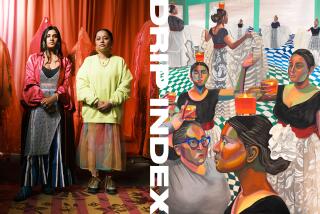Hip apparel brand wants to sell without selling out
When the founders of the L.A. clothing brand the Hundreds first met, they were unhappy law school students looking for a way out.
Six years after they started designing T-shirts to ease the boredom they felt in class, 29-year-old Bobby Kim and Ben Shenassafar are running a humming business, complete with a website, blog and their own mini-subculture out of a storefront in the Fairfax District and a warehouse near downtown.
With a second store in San Francisco and a growing buzz about their products, the pair are now confronting a classic small-business dilemma: They want to expand, and experts say they should. But they don’t want to lose the hip edge that made them popular in the first place.
The Hundreds employs 30 people and sells logo T-shirts, shoes, shorts and accessories including mouse pads and wallets. The brand is a part of a fashion movement known as street wear, which typically consists of casual clothing aimed at quasi-underground subcultures such as skaters and hip-hop fans.
The company’s strategy shows how word of mouth combined with a strong -- and edgy -- online presence can lead to success, especially when the target audience is young adults and teenagers.
Key to the viral nature of its marketing is the Hundreds’ blog, at thehundreds.com, which Kim and Shenassafar started when the clothing line launched in 2003.
The idea, Kim said, was to create a way for young customers to feel connected to the company.
“We said, let’s have it so the kids interact with us and they feel as much a part of it as we do,” he said.
Updated daily by Kim, the website recently registered 1.8 million monthly page views, according to traffic-measuring site Quantcast.com.
The Hundreds shop is one of a cluster of street-wear stores to open around Fairfax Avenue, helping produce a small renaissance in the district’s faded commercial area. Street-wear boutique Brooklyn Projects, near Melrose and Fairfax avenues, was the first to open in 2002.
In 2004, the New York brand Supreme arrived, followed by the Hundreds’ first store in 2007. When John Earle wanted to open a West Coast store last year for his Boston brand Johnny Cupcakes, the Fairfax District was the first place he looked.
“We’re making it a destination spot with these other brands popping up around there,” Earle said.
On the blog, Kim writes about the bustling scene: visits to other street-wear stores, celebrities who stop by the shop, or his favorite place to get a burrito.
A blog post from Thursday features photos of model and disc jockey Anna Dang skateboarding in front of the Hundreds’ warehouse.
“Young brands like this use social media to do a much better job of speaking to the customer than older, more traditional companies,” said Eli Portnoy, a Los Angeles brand strategist and marketing expert. “Their blog creates a forum for exchange, which is what younger people want out of their brands nowadays.”
When the Hundreds started in 2003, most street-wear brands with decades on the scene didn’t have websites or blogs.
“People thought I was just corny and it was pretty nerdy to have a blog you wrote on every day,” Kim said.
But as the Internet became a cultural force and blogging’s popularity grew, Kim and Shenassafar seemed less and less like the odd men out. Other brands started to take notice, said Dominick DeLuca, a former VJ for MTV’s “Headbangers Ball,” who owns Brooklyn Projects.
“I never even heard the word ‘blog’ when those guys started talking to me about it,” DeLuca said. “Now I blog. Everybody has a blog. You can’t have a successful street-wear brand without having a blog anymore. It just doesn’t make sense not to.”
Propelled partly by the success of its blog, the Hundreds’ sales have been growing rapidly. The company made $4.8 million in sales in 2008, up from $1.8 million in 2007 and $900,000 in 2006, Shenassafar said.
Like other street-wear brands, the company’s lines feature T-shirts with bold graphics, layered pieces, strong colors on baseball caps and shoes, hooded sweat shirts and dark denims. The Hundreds products are meant to reflect a Los Angeles sensibility rooted in the 1980s and ‘90s, when its founders were growing up.
In the Hundreds stores, one on Rosewood Avenue and the other on Post Street in San Francisco, bright red and yellow T-shirts, green shoes and purple caps are displayed against black wooden shelves and flooring.
The Los Angeles store is small and narrow, with an art installation of a hill topped with trees and a blue sky by Los Angeles artist Tofer tucked along a wall.
The year-old San Francisco store is almost three times larger and painted black, with shelves set into Batcave-like rock walls and pillars embedded with fake stacked skulls.
Other street-wear brands have grown quite large: Irvine-based Stussy Inc., which started in 1984, has 15 stores in eight countries. Supreme started in 1994 and has seven stores: one in L.A., one in New York and five in Japan.
But the question of how far to expand is particularly tough for a company such as the Hundreds, because its success is predicated on the notion that its products are somewhat underground.
Ilse Metchek, a retail analyst and president of the California Fashion Assn., said the company faces a tough balancing act: The Hundreds needs to grow enough to remain a viable business, but not so much that it loses its street cred.
“If they focus on their core customer base, they could create long-term credibility based on the loyalty they seem to have,” Metchek said.
“That limits just how big they can get. But getting too big would ruin the allure of their brand, so they have to grow and stay small. That’s hard to do.”
She offered as an example the Ed Hardy brand, which expanded into mainstream stores and is no longer as popular among the underground crowd.
“Street-wear brands come and go, and very few show a streak of longevity,” Metchek said. “Ed Hardy started as a street-wear brand, and they expanded and they were everywhere for a while, and they’re already yesterday’s news. They diluted their brand.”
Shenassafar said the Hundreds had been approached by department stores but had decided not to go that route.
Still, when Walt Disney Co. came calling, the partners responded, designing T-shirts, caps and hooded sweat shirts with the Lost Boys from Disney’s “Peter Pan” dressed in the Hundreds gear.
“Everyone’s like ‘Doesn’t that go against everything in your ethos?’ ” Kim said.
“If we can use it to our advantage -- to where the man is not using us, but we’re using him to gain exposure and to make it look like we’re beating Goliath -- I’m going to do it.”
--






